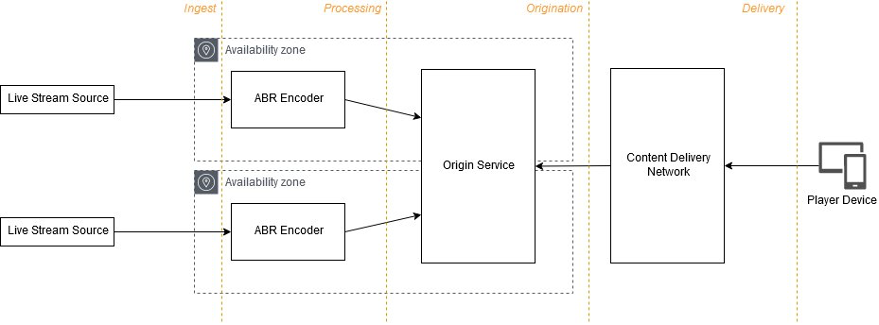Scenario: Live streaming
Live video streaming is core to many exciting events, news, and interactive experiences. It is used extensively in social media, sporting events, corporate streaming, e-sports, broadcast TV, as well as IoT and security camera applications. Due to the real-time nature of live content, special considerations must be taken when architecting live streaming solutions. As with other streaming media workflows, the fundamental architecture components include ingest, processing, origination, and delivery.
One of the unique challenges of live video streaming is that the value of the content being streamed decreases exponentially as time passes from the live point. For example, many people might want to watch a sporting event live, but the number of viewers who watch the event hours or days after it takes place tends to decrease as time goes on. Distributors only have one chance to get a live event right, and do not have the luxury of asking viewers to come back later when issues are resolved. As such, it is critically important to ensure that live streaming workflows are optimized for reliability and performance.
The cloud is uniquely suited to handling these challenges, with its regional diversity, availability, and elastic scalability. By decoupling the various services involved in live streaming, reliable and performant workflows can be built that are cost effective and where the various architecture components can scale elastically to handle variations in demand or in live stream counts. It also allows flexibility to include value added services, such as machine learning technologies to perform actions such as automated closed caption/subtitle generation or content tagging/indexing. This type of redundancy, scalability, and developer flexibility is not possible with monolithic on-premises live streaming applications. The following diagram illustrates a sample live streaming workflow using redundant sources and a Multi-AZ architecture:

Live streaming architecture
Considerations
-
Amazon Interactive Video Service (Amazon IVS) is a managed live streaming service that manages low-latency interactive live streams on your behalf. Consider using Amazon IVS if you don’t want to manage your own live streaming service.
-
Ingest your video content in the AWS Region that is closest to the source of the stream.
-
Where subsecond latency is required (that is, video conference-like applications) protocols such as WebRTC should be considered. However, these solutions do not scale as effectively for one-to-many distribution as they require stateful connections with backend origin services. Amazon Kinesis Video Streams and Amazon Chime SDK can both be used to implement WebRTC into your applications.
-
Use a reliable ingest protocol such as Zixi, SRT, RIST, RTP-FEC, or RTMP as these are designed to improve reliability over unmanaged networks, such as the internet.
-
Consider source ingest within at least two AWS Availability Zones from diverse network paths.
-
To reduce delivery and storage costs, explore compression technologies such as AWS Quality-Defined Variable Bitrate (QVBR)
that provide streams at lower bitrates but equivalent video quality. -
Use an origin server specifically designed and optimized to support the latency and data consistency models required for live streaming.
-
Origin hosts can scale to serve streams to tens or even hundreds of viewers, but it is always recommended to use a CDN such as Amazon CloudFront to scale live stream delivery beyond a handful of viewers.
-
Refer to the Live Streaming on AWS
solutions implementation for a well-architected reference architecture for live streaming.